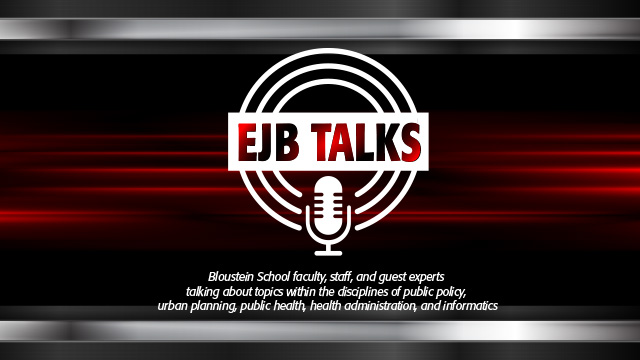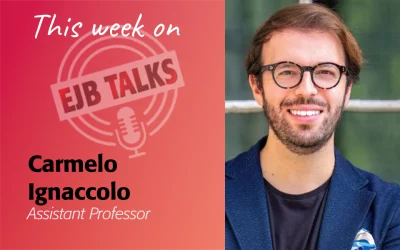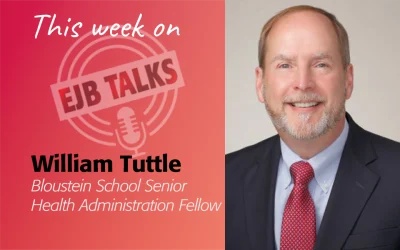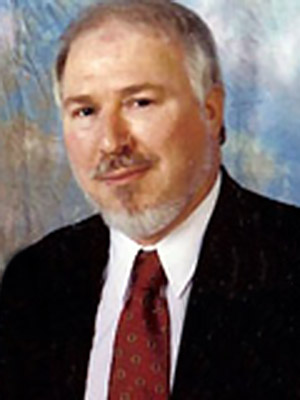
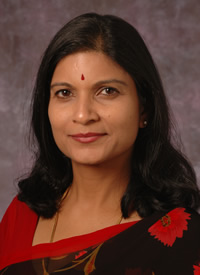
On this episode of EJBTalks Stuart Shapiro welcomes Bloustein School colleague Professor Radha Jagannathan and Professor Michael Camasso from Rutgers’ School of Environmental and Biological Sciences (SEBS) to discuss their shared interest in social welfare program evaluation and their program Nurture through Nature (NtN). They discuss the after-school and summer program NtN provides for students in the New Brunswick school district and how their rigorous program evaluation methods are in place to ensure NtN produces measurable positive progress in student development. They also touch on the positive impacts the program had on their first graduated cohort, the challenges the COVID19 pandemic has brought, and program expansion possibilities both locally and globally.
Stuart Shapiro
Welcome to EJB Talks. I’m Stuart Shapiro, the Associate Dean of the Faculty at the Bloustein School. And the purpose of this podcast is to talk with my colleagues and our alumni about policy, planning and health, the interaction between these fields and how they affect people in New Jersey, the United States and the world.
Today, I’m very happy to have professors Radha Jagannathan, who is a professor in our nationally ranked Urban Planning program, and Michael Camasso, a professor in the Rutgers Agriculture and Food Economics department. Together, they run the Rutgers Nurture through Nature (NTN) program. Welcome to the podcast, Radha and Michael.
Radha Jagannathan
Thanks for having us, Stuart.
Michael Camasso
Yes, thanks.
Stuart Shapiro
Radha, let’s start with you. Since you’re my Bloustein connection here. A lot of your work has been about evaluating government programs to improve social welfare. How’d you become interested in this?
Radha Jagannathan
So this is something you probably don’t know, or many people don’t know. But, I had my start at Rutgers back in 1983, working as a project secretary in the School of Social Work. And I was working on a project that involved evaluating the efficacy of the welfare system, particularly the training program that was given to frontline workers, the public welfare system in Essex County. So coincidentally, Michael was hired as the methodologist for the project for the evaluation work. And that’s when we met. So we’ve been working together since 1983. He has known me since I was yay high… presently I’m still yay high ((laughing))
Stuart Shapiro
((laughing)) For the audience, Radha is not much more than yay, high, right?
Radha Jagannathan
((laughing)) So… and I worked on that project. And slowly, my functions kind of expanded from being secretarial to a research assistant, and then I became a research associate. And at the same time, I was also going to school. So I was taking classes on regression and stuff like that. And I had a unique situation where I could actually relate classroom learning to actual project work, which involved evaluating social programs.
So that’s, I think, how I became interested. I was kind of indoctrinated into that field by Michael Camasso. So that’s how I began. And then, soon one thing led to another and there were other projects. Once you have this evaluation, toolkit Master, you could bring it into just about any substantive area that you’re called to do work.
Michael Camasso
I had done a number of evaluations in Pennsylvania and New York. And I had run a number of youth services programs. And there was an evaluation component to all of those. And when I was finishing up my Ph.D., I had a number of job offers. And one of them was to come to Rutgers. And part of it was to evaluate the public welfare system of Newark, New Jersey. And this was a pretty high-profile project. And that’s as Rahda said, that’s where I met Rahda.
And I’ve always been interested in this accountability factor and basically trying to get hard evidence of whether or not a program works or not. And in Ag economics at Penn State we learned a lot of statistical methods, a lot of methodological techniques, I guess you would say, to evaluate programs. A lot of that has already been done in agriculture for years and years. And bringing it to human services was something that was interesting to me. And that’s what I ended up doing. And we kept on doing that for years after that. Ever since I’ve been here in 1983. I took some time off and I came back again. The long and short of it, we’ve evaluated millions and millions of dollars worth of programs on the federal level and state levels, basically, in human services, employment…
Radha Jagannathan
And at very local levels too, like New Brunswick, for example.
Michael Camasso
Yeah. And that’s how we got into Nurture through Nature and some of the issues. Because it all appears to come back to human capital development, especially for young people. Young people that don’t do well in school, end up in some of the other systems we looked at. Like the welfare system, the current criminology and the corrections systems, the child welfare systems, and DYFS. It all starts with the schools, and it ends up badly for a lot of young people. And they end up in those systems.
Stuart Shapiro
I definitely would love to explore some of those things a little further. But I know we want to focus a little bit on Nurture through Nature here. So let me turn to that, maybe we’ll come back to some of the program evaluation stuff, depending on time, but can you for the audience explain what Nurture through Nature is?
Radha Jagannathan
Sure. It’s an after-school and a summer program, or what it commonly comes under Out of School Time programs, OSD programs. And we found that a program to help bridge the gap between more affluent school districts and the New Brunswick School District, so we could provide the same kind of quality education, focused on STEM learning for kids either after school and more intensively during the summer. So that’s basically what it does. It just improves their academic grades in math and science and language arts. And it also is aimed at increasing their interest in STEM disciplines, whether they want to move on to higher education STEM fields, or to join the labor force in STEM careers. So that’s basically the objective of the program. And the name comes from our desire to have the program be inspired by nature, and assisted by technology. So that’s, that’s what we do.
Stuart Shapiro
So when did it get started?
Radha Jagannathan
Back in 2010. So we are in our 11th or 12th year, right now.
Stuart Shapiro
And what age kids are we talking about here?
Radha Jagannathan
Well, we cater to kids eight years, all the way through high school. Third grade through 12th grade. So the very first cohort that started with us in 2010, graduated high school in 2019. And we actually had a celebratory graduation, NTN graduation function at the Bloustein auditorium.
Stuart Shapiro
That’s great. So kids stick with it for years, for summer after summer, as they’re going through school there.
Radha Jagannathan
It’s a longitudinal study, and we designed it as a randomized experiment. So, we can actually easily read off what impact the program has because we have a control group that doesn’t participate in any of the activities. So every event of every year, we get academic data from the New Brunswick school system. And we also additionally do some surveys of both the NTN group and the control group. And then we analyze the data to see or demonstrate to both the funder and the school system that the program is working or not working.
Stuart Shapiro
And has it been working?
Radha Jagannathan
Yep. So our data show that most of the cohorts are showing improvements in their cognitive testing, like math and science and standardized testing, and so forth. So we have published our findings, this has been a very long demonstration. Ten years is a long time….
Stuart Shapiro
Yeah, ten years is a long time to collect data.
Radha Jagannathan
Right. And our most recent data show that the program has been successful in increasing the science and math scores of the NTN students relative to the control students by about .4 standard deviations, which is a big effect size in education.
And we also look at non-cognitive skills such as the ability to get along with others, pro-social behavior, higher-order thinking, like problem-solving, leadership skills, that kind of stuff. And conscientiousness, like being punctual, having grit, or stick-to-itiveness, as it’s called. So there the effect is even more dramatic. The control group is flat. The NTN group is like, WOH, up by .8 standard deviations.
Stuart Shapiro
That’s great. I know, grit was becoming a very big thing in education policy, about maybe the middle of the last decade, a decade ago or so. It really started to pick up there. So that’s great. So you through exposure to nature and technology? Can you tell us what that means in practice?
Radha Jagannathan
So … do you want to jump in Michael?
Michael Camasso
No, you could do this part.
Radha Jagannathan
So one of the projects, for example, technology takes a lot of inspiration from nature, like the dragonfly could be a model for drones.
Stuart Shapiro
Ah hah.
Radha Jagannathan
So we actually help kids realize that what technology copies, it’s called biomimicry. We introduce kids to identifying butterflies and dragonflies. Our kids can tell the difference between male and female tiger swallowtails…
Stuart Shapiro
Oh my goodness!
Radha Jagannathan
Monarchs and…
Michael Camasso
Viceroys.
Radha Jagannathan
Viceroys… which look very similar to the naked eye. So these kids… so our objective is to really train them in classification, identification, which really forms the basis for critical thinking. Critical thinking can’t exist in a vaccuum you need to have a knowledge base that you can use. So that’s been our objective. And that’s how we bring nature and technology together.
Stuart Shapiro
Gotcha. I see.
Radha Jagannathan
We have a ton of hands-on experiments that there are people from the physics department, faculty from the physics department, people from the nursing department and people from the biology department, directors, they all come in and do hands-on experiments with our kids.
Stuart Shapiro
That’s wonderful. So tell us, I guess now some of your earliest kids are in college. Do you continue to track them? Do you have success stories about where they are now?
Radha Jagannathan
Sure. I think they’re in their second year. One is in Penn State one is at Ohio State. One is in… I don’t want to give off names. One is at Farleigh Dickinson. One is at Ryder. There are four of them are Rutgers. One in engineering school. And they’re all doing really well. And anytime we want them to come and talk to the younger cohorts, about their own experiences, and how important it is to attend each NTN session, they will come at the drop of a hat.
Stuart Shapiro
That’s really great.
Radha Jagannathan
So we keep in touch with them. And some of them have… one of them has had an important internship from the Defense Department. And he’s placed at the Institute for Advanced Physics at Princeton.
Stuart Shapiro
Yep.
Radha Jagannathan
So they’ve had a lot of success, and they still keep in touch with us. They’re very grateful for their NTN experience. And they tell us that, even though it’s anecdotal from them, they tell us that they wouldn’t have pursued the particular subjects they’re pursuing if it weren’t for their participation in NTN.
Stuart Shapiro
That’s great. Narrative helps too. Stories help too in terms of….
Radha Jagannathan
Yes, it’s personalized it’s humanized…
Stuart Shapiro
That’s absolutely right. So I have to imagine that last year was tough, right? For the program with the pandemic and such. How did you deal with that? How has 2021 been different so far than 2020?
Radha Jagannathan
Well, we switched just like we did at the Bloustein School and elsewhere at Rutgers, we switched completely to remote learning. And because the public schools had also switched to remote learning, there was a lot of screen fatigue, from your students…
Stuart Shapiro
Yes… my kids have it, I can tell you that much.
Radha Jagannathan
Yeah. So we had to shorten the sessions, instead of two days a week we did it maybe, one day a week or split into smaller chunks. We still continue to do online experiments, hands-on experiments online. We would drop off all the supplies for the experiment the night before, or the week before at the individual homes. They would use that when it came time for their session. So, we haven’t missed a beat. Maybe a small beat…
Stuart Shapiro
A half a beat. So do you envision getting back to being in person this fall? Or what’s the goal in terms of that?
Michael Camasso
That is going to be… this is going to be a very difficult situation we have because the schools in New Brunswick, until this point, have not had the kids back in school at all.
Stuart Shapiro
Not at all?
Michael Camasso
No, they have been fully remote. Some districts have had them in for a few days. Apparently, starting the middle of April, we’ll be able to come back for two days a week. But, the year is almost over. We’re going to have to build back again. We’re talking about a summer program again. And just like the university has suffered in terms of students who have not continued because they’d like to be on campus, in person. We’ve had this kind of situation happen with our kids too. So it is going to be,,, we’re going to have to wait and see. If we do a summer program, it’s still not clear yet what the protocols are at the public school as to whether or not groups of students can meet together in the summer. So we don’t know. And then we’re going to have to find out, just like Rutgers is going to have to find out in September, how this goes when everybody comes back, or most people come back. It’s really created a problem for us.
Radha Jagannathan
There are a lot of variables that are still unknown.
Michael Camasso
To go back to your earlier question about the first cohort. We had 17 people. Out of 17, 7 of our students are in four-year colleges, we got three of them on scholarships. We got about three in the engineering school, right?
Radha Jagannathan
Two in engineering.
Michael Camasso
Right… And if you took random samples of New Brunswick students, 17 at a time, you’re never going to get those kinds of numbers with other groups. So we, we published in the Cambridge Journal of education, the economics of education, journal, and a lot of other leading journals. We think we show a pretty good effect.
The problem we’ve got on the hard skills is that what we do is, we slow down a decline. If you take a look at math scores in poor districts, they tend to decline over the years. And we have slowed that down, but we have not raised it. And, no one has. But we slow the decline down. And there’s a thing called summer fallback. And it happens to poor district kids, because middle class through this and more advantaged districts, they’re able to send their kids to summer school and tutoring that these families don’t have the means.
Radha Jagannathan
And that’s really our objective. To give them that.
Michael Camasso
Yes. So you have a ratcheting effect down, you’re trying to stop it from going down each summer. And of course, we’ve had this happen last summer and now possibly getting this summer. So it really creates an issue for us. But empirically we track this, and we have some pretty hard evidence. And that’s why it’s hasn’t been very difficult for us to publish in pretty good journals with this kind of thing. And we’ve actually even done it overseas now. We’ve done some in Spain. And we’re doing a program in Italy.
Radha Jagannathan
We did a Jersey Roots, Global Reach project.
Stuart Shapiro
Oh very nice!
Radha Jagannathan
We took something very local in New Brunswick, the NTN program, and we transported it to Granada, Spain, and Catania in Italy.
Stuart Shapiro
Great.
Radha Jagannathan
Those have been of shorter duration. So we haven’t really had systematic data collection or results published for one year. I mean, these are not outcomes that are amenable to changes overnight.
Stuart Shapiro
Sure.
Radha Jagannathan
So it’s a longitudinal look. And that’s exactly what NTN provides, we have a pretty good model. Here we have a successful (((look))))
Stuart Shapiro
So it’s interesting to me, you were talking about that summer fallback. A lot of people are worried that what we have right now, because of the pandemic, is a year and a half… Well, what we will have is a year and a half of summer fall back. You know, because remote learning is different than in-person learning and attendance at remote learning is worse than attendance in in-person learning.
Radha Jagannathan
We see that even in our own classes.
Stuart Shapiro
Absolutely. Absolutely.
Radha Jagannathan
These are young kids you’re talking about. So you know, multiply that by a factor of 10.
Stuart Shapiro
Yeah, absolutely. So what is the long-run plan for Nurture through Nature? You talked about doing it elsewhere and replicating it elsewhere. Is it something that you think you will expand either here in New Jersey, in the United States, etc? What are your long-term plans?
Radha Jagannathan
That’s definitely in the works. So we have been… I mean, the year, of course, has set us back with respect to seeking funds to expand the program. But we have every intention of selling this model or marketing this model to other school districts because we have… our data is pretty robust. Our findings are pretty robust. And they come from a pretty robust research design, experimental design. So we have something to show and something to share with other school districts. So that’s one track.
The second track we’ve been working on is Vonu (Dean Thakuriah) actually introduced us to Anna Branch who is the VC for diversity, equity, and inclusion. So they’ve been giving the DI paradigm a lot of importance at the university. And Vonu correctly thought that this program fits into that paradigm really nicely. And what we would like to do is… she said she had a meeting with the provost and Ana Branch for the two of us and what we would like to ask is…we are at the ready to implement the university’s more recent mission of DI. And if this program isn’t DI don’t know what else is d DI?
Stuart Shapiro
Yes, it certainly sounds like it is.
Radha Jagannathan
That’s the second. So the reason we did it that that way… we’ve been fundraising for the program nonstop. We write three, four, or five proposals every year. We actually have an NSF proposal that’s pending. We’re waiting to hear back from people. So we realize that if this program has to continue, it’s imperative that it become institutionalized. It cannot be institutionalized in the school system, because they don’t have enough resources. So it’s got to be institutionalized at Rutgers. And that’s why we are really eager to meet with Ana Branch and the others to see that we are not existing like hand-to-mouth. So there’s constant funding so we can actually focus on strengthening the program rather than writing proposals every two days.
Stuart Shapiro
Yeah, institutionalization is always a challenge. Thank you both for coming on. It’s been great to hear about this program, and great having you on.
Radha Jagannathan
Thanks Stuart!
Michael Camasso
Thanks!
Radha Jagannathan
I’m always happy to talk about NTN.
Stuart Shapiro
Wonderful, and thanks. Thanks also to Amy Cobb and Karyn Olsen, who help make the podcast run. We’ll be back next week with another talk with another expert from the Bloustein School. Until then, stay safe.

